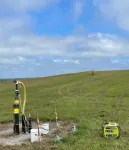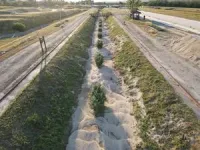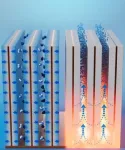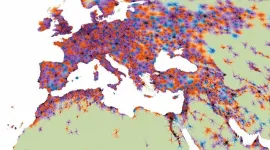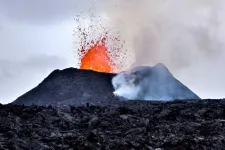Some landfill ‘burps’ contain airborne PFAS, study finds
2024-06-26
(Press-News.org) Many municipal landfills “burp” gas from decomposing organic matter rather than letting it build up. And burps from buried waste containing per- and polyfluoroalkyl substances (PFAS) can release these “forever chemicals” into the air, say researchers in ACS’ Environmental Science & Technology Letters. Their study reports unexpectedly high levels of airborne PFAS at three landfills and demonstrates that vented gases and liquid by-products called leachates could transport similar amounts of these contaminants to the environment.
Some consumer products and commercial waste, such as children’s clothing, cosmetics and wastewater treatment sludge solids, contain PFAS — and they ultimately end up in landfills. Timothy Townsend and colleagues previously established that PFAS-containing waste can contaminate the water that seeps through landfills. This leachate is usually captured and treated before entering the environment. Landfills also produce gas that can be captured and controlled, but unlike leachate, it’s often released untreated. The burped gas is mostly made up of methane and carbon dioxide; however, two recent studies also discovered a subset of airborne PFAS called fluorotelomer alcohols, which have the potential to be toxic when inhaled and can be transported long distances. Since the prevalence of PFAS-contaminated landfill vapors isn’t yet widely known, Townsend, Ashley Lin and their team wanted to identify and measure them in vented gas at three sites in Florida.
The researchers pumped landfill gas from pipes through cartridges filled with resin that captured the airborne PFAS. They freed the compounds from the cartridges with organic solvents and analyzed the extracts for 27 neutrally charged PFAS, including fluorotelomer alcohols. Surprisingly, some of the fluorotelomer alcohol levels were up to two orders of magnitude higher than previous studies at other landfills. Three of these alcohols (abbreviated 6:2, 8:2 and 10:2) comprised most of the vaporized contaminants measured at each site. The researchers also collected leachate samples at the Florida sites and analyzed them for ionic PFAS commonly found in water samples. From this data, they estimated that the annual amount of fluorine (as a proxy for PFAS content) leaving the landfills through gas emissions could be similar to, or even greater than, the amount leaving through leachates.
Because landfills are repositories for PFAS, this work indicates that vented gas from these sites should be considered in future mitigation and management strategies to reduce potential inhalation exposure and release to the environment. Some landfills burn the vapors or trap them for energy production, and the team suggests that further research is needed to determine the degree of removal these treatments provide for airborne contaminants.
The authors acknowledge funding from the Florida Department of Environmental Protection and from the U.S. Environmental Protection Agency under the Science to Achieve Results grant program.
The paper’s abstract will be available on June 26 at 8 a.m. Eastern time here: http://pubs.acs.org/doi/abs/10.1021/acs.estlett.4c00364
For more of the latest research news, register for our upcoming meeting, ACS Fall 2024. Journalists and public information officers are encouraged to apply for complimentary press registration by completing this form.
###
The American Chemical Society (ACS) is a nonprofit organization chartered by the U.S. Congress. ACS’ mission is to advance the broader chemistry enterprise and its practitioners for the benefit of Earth and all its people. The Society is a global leader in promoting excellence in science education and providing access to chemistry-related information and research through its multiple research solutions, peer-reviewed journals, scientific conferences, eBooks and weekly news periodical Chemical & Engineering News. ACS journals are among the most cited, most trusted and most read within the scientific literature; however, ACS itself does not conduct chemical research. As a leader in scientific information solutions, its CAS division partners with global innovators to accelerate breakthroughs by curating, connecting and analyzing the world’s scientific knowledge. ACS’ main offices are in Washington, D.C., and Columbus, Ohio.
To automatically receive news releases from the American Chemical Society, contact newsroom@acs.org.
Note: ACS does not conduct research, but publishes and publicizes peer-reviewed scientific studies.
Follow us: X, formerly Twitter | Facebook | LinkedIn | Instagram
END
ELSE PRESS RELEASES FROM THIS DATE:
2024-06-26
Clean, safe water is a limited resource and access to it depends on local bodies of water. But even dry regions have some water vapor in the air. To harvest small amounts of humidity, researchers in ACS Energy Letters have developed a compact device with absorbent-coated fins that first trap moisture and then generate potable water when heated. They say the prototype could help meet growing demands for water, especially in arid locations.
Earth’s atmosphere holds trillions of liters of fresh water as vapor, but it’s challenging to collect this colorless, transparent and dilute gas. Previously, researchers developed systems that trap ...
2024-06-26
Comprising the base of the food web, plankton are extremely important to marine ecosystems. However, there is still much to be discovered about these organisms, and that’s especially true for mixoplankton.
Plankton are typically divided into two groups. Similar to plants, phytoplankton contain chlorophyll and derive energy from photosynthesis. Zooplankton, on the other hand, consume other organisms for their energy. However, there is also a third group, mixoplankton, that is a combination of the two. And, despite accounting for, at times, more than half of all plankton in the ocean, they remain ...
2024-06-26
River plants provide ecological and environmental benefits, but they raise flood risk by blocking the flow during heavy rain. Removing woody riparian vegetation patches is a primary flood prevention method, but it threatens stream's biodiversity. The research team at the Korea Institute of Civil Engineering and Building Technology (KICT, President Kim, Byung-Suk) has developed a technology for quantifying the effect of river vegetation patches on flood level changes to aid in better decision-making of river management for balancing ecological benefits and flood mitigation.
Rivers ...
2024-06-26
Marine organisms produce many organic compounds with diverse chemical structures and biological activities. These natural marine products are regarded as potential starting points for the discovery and development of new drugs. Among these are norcembranolide diterpenes isolated from the soft corals of the genus Sinularia. These compounds exhibit diverse biological activities, and many of them have anti-cancer and anti-inflammatory properties. Consequently, many studies have investigated the properties of norcembranolide diterpenes and their synthesis methods. Given their potential in drug discovery, developing a synthetic ...
2024-06-26
JACKSONVILLE, Florida — The blood-brain barrier — a network of blood vessels and tissues that nurtures and protects the brain from harmful substances circulating in the blood — is disrupted in Alzheimer's disease. Now, researchers at Mayo Clinic and collaborators have uncovered unique molecular signatures of blood-brain barrier dysfunction that could point to new ways to diagnose and treat the disease. Their findings are published in Nature Communications.
"These signatures have high potential to become novel biomarkers that capture brain changes in Alzheimer's ...
2024-06-26
Rome - Rural livelihoods are quite intertwined with urban centers, with mid-sized cities playing an extraordinary role in providing required services, including for food security, agricultural livelihoods and viable rural development, according to a new study by researchers at the Food and Agriculture Organization of the United Nations (FAO) and other institutions.
Some two-thirds of the world’s population, or more than 5 billion people, live within one hour of travel time – using locally available means of ...
2024-06-26
A discovery by researchers at the University of British Columbia promises to improve care for patients with endometrial cancer, the most common gynecologic malignancy.
Using artificial intelligence (AI) to spot patterns across thousands of cancer cell images, the researchers have pinpointed a distinct subset of endometrial cancer that puts patients at much greater risk of recurrence and death, but would otherwise go unrecognized by traditional pathology and molecular diagnostics.
The findings, published today in Nature Communications, will help doctors identify patients with high-risk disease ...
2024-06-26
The COSPAR Panel on Innovative Solutions (PoIS) charter aims to bring state-of-the-art technology to address the hardest problems facing COSPAR researchers. PoIS first focused on predicting adverse events from solar activity and applying innovative technologies and sophisticated tools to atmospheric modelling of Mars, Earth, and Venus. This effort led to the creation of the Cyprus Space Research and Innovation Center (C-SpaRC), co-funded by the European Union (EU) in December 2023 as a new infrastructure with related research, with the cooperation of COSPAR. C-SpaRC is now under the auspices of COSPAR, and is designated the COSPAR International ...
2024-06-26
Given the volcanic activity on Iceland over the last three years, researchers from six universities anticipate recurring, moderately sized eruptions of similar style in the coming years to decades. They therefore stress the need for preparedness in view of the risks posed to local populations and critical infrastructure. Their study was recently published in the scientific journal Terra Nova.
“The study uses information from local earthquakes and geochemical data on the erupted magma through time to reveal the geological processes behind these recent Icelandic eruptions. A comparison of these eruptions with historical events provides strong evidence that Iceland will ...
2024-06-26
A study led by a Brigham investigator evaluated a novel device that automatically measures blood pressure at the wrist, generating hundreds of readings within days that may help clinicians determine cardiovascular risk and improve hypertension care
High blood pressure, the leading risk factor for death worldwide, is present in one in every two adults. Only one-quarter of individuals with hypertension have their blood pressure under control, highlighting the need for innovative strategies for blood pressure management. A study led by an investigator from Brigham and Women’s ...
LAST 30 PRESS RELEASES:
[Press-News.org] Some landfill ‘burps’ contain airborne PFAS, study finds
